
5 Secrets of the Orcia DOC
Some people call the Orcia DOC “The Other “Tuscany” Wine Region.”
Tuscany shines as a famous wine tourism region – noted for its red wine made from the Sangiovese grape.
Italian wine.
Yet what of Tuscany’s neighbor, the Orcia DOC?
Located a stone’s throw from the prestigious Montalcino region, the Orcia Doc is earthy by comparison.
Wild and rustic, you will find beauty in Orcia’s jagged, flinty vineyards.
Each night, dazzling ochre colored sunsets paint the sky.
Orcia DOC: The Story
Orcia DOC is the home of Orcia Sangiovese red wine.
The story of the Orcia DOC (Denominazione di Origine Controllata) began on February 14, 2000.
For decades Orcia DOC vineyard owner Roberto Mascellione of Poggio al Vento had been frustrated. Why are the vineyards of Orcia ignored while nearby regions prosper?
The growing conditions, and the soil, are as good – and better – than other DOC and DOCG regions. How much longer could Orcia be ignored?
With the hard work of Roberto Mascellione and ten hardscrabble producers, February 14 2000 marked the day of their reward.
They received the Denominazione di Origine Controllata.

Inside the Orcia DOC
Like most DOC and DOCG regions in Tuscany, Sangiovese comprises the majority of production.
Yet the Orcia DOC denomination also includes white, rose, and the sweet, long aged wine called “Vin Santo.”
And like the other regions, regulations point to specific proportions of Sangiovese that must be used, specific aging requirements, and so forth.
What’s interesting to note about the Orcia DOC is that the red wine is classified according to the percentage of Sangiovese in the wine. As well as the length of time the wine spends in oak.
According to the regulations of the region, 90% of Sangiovese is required for the Orchia Sangiovese DOC quality level. A common partner with the Sangiovese grape is Merlot, Cabernet Sauvignon, or other local red varieties.
Orcia DOC Producers
The Orcia DOC region, lying south of Sienna, is characterized by terrain as wild and free-natured as the personalities of most of the producers.
Every Orcia DOC producer could easily be characterized by a streak of creativity, independence, and verve not easily found in producers located in the more established wine regions.
Orcia DOC: Poggio al Vento
This is a winery and agritourismo in the region of Castiglione de Orcia. The farmhouse offers modernized rooms, and encapsulates the “romance” that many people have idealized about Tuscany for centuries.
Charming and charismatic owner Roberto Mascellione greets guests upon arrival.
Roberto is a pioneer of the region. As a very young man he bought this farmhouse and the vineyards with his parents.
Then he began to market the wine and the farmhouse as an agritourismo (basically, a “bread and breakfast” in the countryside).
The rooms at this farmhouse have different layouts, which you can see at the Poggio al Vento website.
You can look at the rooms and choose the one that suits your needs best. My room was on the first floor with a fully equipped kitchen, comfortable bedroom, and modern bath.
Breakfast at Poggio al Vento is similar to your fantasy of a breakfast if you were part of an Italian family producing wine in the Orcia DOC region.
Mama and Papa (Roberto’s parents) are in the kitchen supervising the help and setting out anything you might need – eggs, cereal, yogurt, fruit, bread, etc.
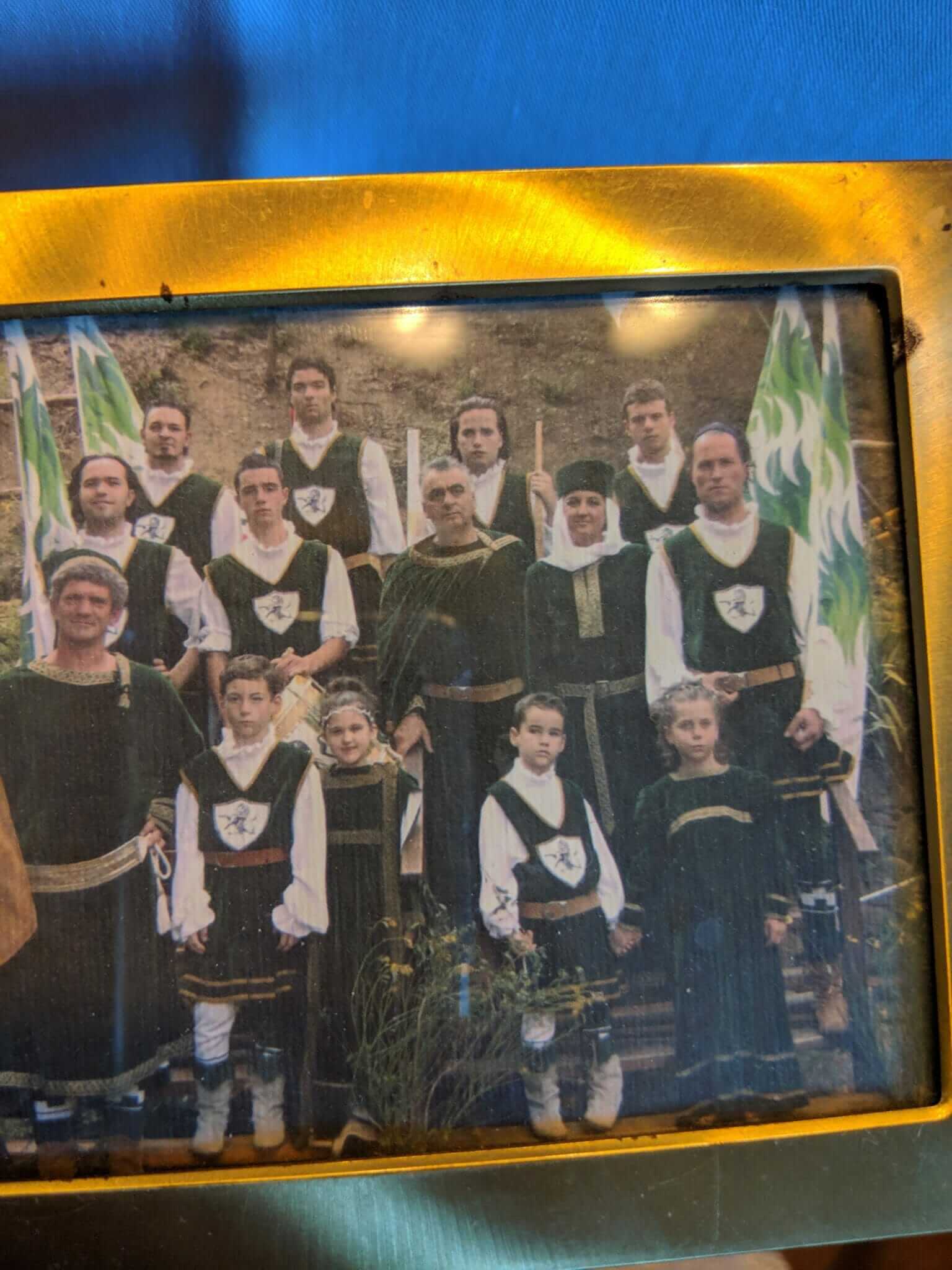
And of course there is the excellent olive oil the family produces.
Though the olive oil here is superior – and many visitors come here “only” to taste the olive oil, the wine is even better.
Roberto tells me that many visitors who arrive for the olive oil tasting actually end up shipping both olive oil and several cases of wine home.
During the personal wine tasting, Roberto presents his top three wines. Each wine bottle has the symbol of an Archer on the label or etched on the bottle. The symbol represents Roberto’s mastery of the archery sport.
Orcia DOC: The Wine Tasting at Poggio al Vento
We start the tasting with the entry level 2014 Giallo Toscana, which is made from 70% Sangiovese and 15% each of Merlot and Cabernet Sauvignon.
Fermented and aged in stainless steel, it is a refreshing and delicious wine with a bright red cherry flavor.
The second wine was the 2015 Mascelloni Orcia “Or” Sangiovese Biologico, which was made from 90% Sangiovese and 10% Merlot.
This wine had some oak maturation and was characterized by supple velvet tannins and vibrant acidity with a very long length of finish. Complexity was represented by nuances of both black and red cherries.
The third wine, 2015 Mascelloni Arcere, was my favorite. It was made from 80% Sangiovese and 10% if the local grape Foglia Tonda (meaning “big hill”) and 10% of the international Merlot grape.
All varieties were aged in separate barrels and then blended together. The wine was full bodied with a long length of finish and very delicious.
After the tasting, Roberto took me to see his cellar and his vineyards. The vines before us were framed by an incredible mountain landscape and absolutely picture perfect.
This is a “panorama” destination you must see and experience.
Orcia DOC: Fattoria del Colle
The Orcia DOC is characterized by such a natural beauty it attracts millions of visitors a year.
Some are drawn by the region’s fantastic wine. Others by its equally famed olive oil.
Yet a portion of these “nature-lovers” are also sybarites who enjoy fabulous world class restaurants in their agritourismo and also “five-star” attention to detail in their rooms.
These Orcia DOC lovers will find a perfect home at the agritourismo Fattoria del Colle in Trequanda.
The agritourismo and its grounds and vineyards encompass 18 hectares.
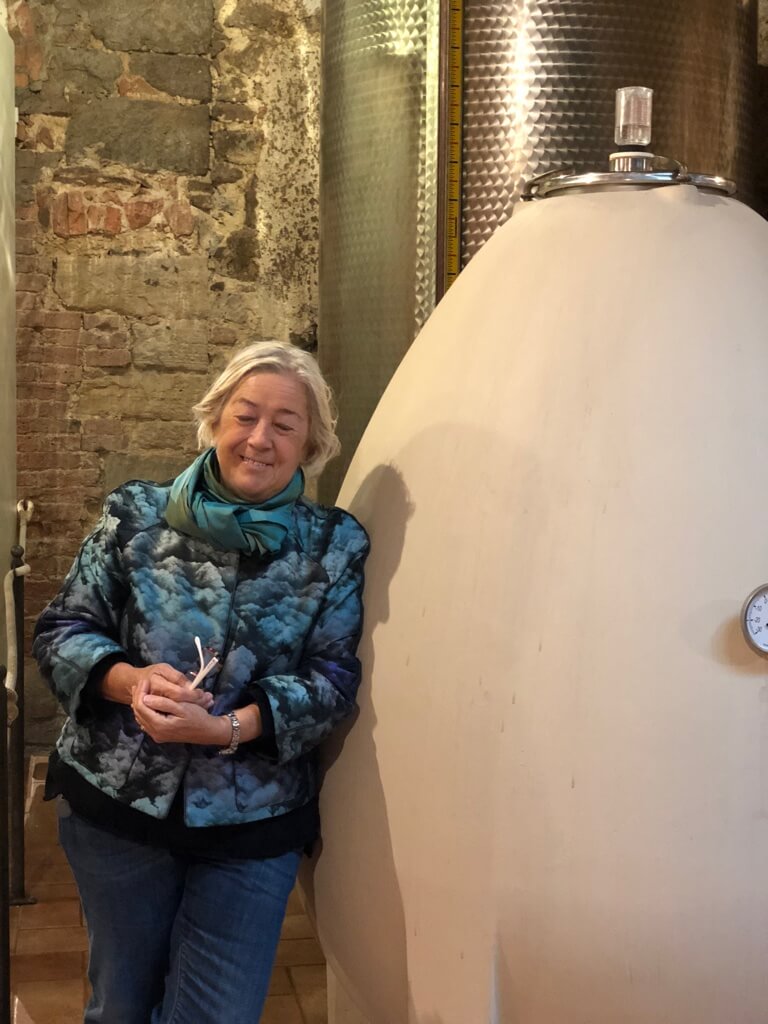
Donatella Cinelli Colombini
They are owned by the energetic Donatella Cinelli Colombini, an Italian aristocrat whose family owned the winery, farmhouse, and castle-like “manor” since 1592.
Donatella graduated university with a degree in the history of Medieval Art.
She could have gone on to be a lady of leisure in fashionable Milan or elsewhere.
Yet as her parents owned vineyards, she felt compelled to make her mark on both the wine and tourism industry.
Eventually she did this by creating a thriving and well respected international wine business that highlighted the best quality Sienna could produce.
This desire was born in 1998 when she took over a family vineyard in Brunello di Montalcino, and another one – the Fattoria del Colle – where we now sit and speak.
When Donatella’s first grapes were about to be harvested, she called the Siena oenology school and asked to hire a winemaker. The response was that “no one” was available.
Female Oenology Focused
Donatella soon discovered the man meant “no male” oenologist was available.
It turned out that one of the few female oenology students, forgotten by the school and “important” wineries, happened to be available.
From that point on Donacella made it her mission to promote women.
She does this primarily through her Brunelllo di Montalcino Prime Donne project that promotes the concept of wine made by women.
How Wines Are Chosen in the Brunelllo di Montalcino Prime Donne project
The best lots are selected by a panel of very high profile female “super tasters” that choose the wine and decide how long it to age in barrels.
One of the super-tasters of this group is Rosemary George MW.
Cenerentola DOC
Donetella is also noted for her award-winning Cenerentola DOC, wine based on the native grape Foglia Tonda and Sangiavese.
Passion for Agritourismo
Wine is a great passion of Donatella, yet not the only one.
She has done a magnificent job of restoring the family estate Fattoria del Colle into several independent apartments and rooms within the manor house.
Fattoria del Colle has the appeal of a medieval castle, with built in modern comforts (modern appliances, luxury bedding).
Fattoria del Colle Restaurants
Guests can request the apartments or rooms with well-stocked kitchens. Yet many would prefer just to visit the restaurant a few steps from their rooms.
The restaurant offers floor to ceiling views of the gorgeous forest and features wine and house made olive oil from the estate.

Fattoria del Colle Summer Activities
In summer you will find three different pools, as well as a “turtle park” where one can view these creatures.
More interesting, perhaps, is taking part in a “truffle hunt” on the property. One enters the forest that Donatella owns with a guide and his dogs. When I made this fun journey, we found enough truffles to feed more than twenty people for dinner.
Touring the property is an adventure in itself, as the guide will show you the different “parts” on the estate built over the centuries.
The winery alone is built on four levels, some more ancient than others. The winery equipment is very modern and barrels of the highest quality.
Guests will also find a new spa, with a meditation area, hot tubs, a sauna, and treatments that involve grape skins.
Fattoria del Colle & Montalcinbo Wines
Brunello di Montalcino DOCG & Brunello di Montalcino Riserva DOCG
The wine comes from six of the best vineyards in the region, with aging in oak for at least two years.
Of the vintages tried, the 2012 Riserva was my favorite.
Brunello di Montalcino Prime Donna DOCG
This is the wine blend that is specially chosen from barrels and vineyards each year by four female experts. Four more women judge the wines.
Rosso di Montalcino
Lighter style with lots of fresh red cherry flavor.
Cenerentola (Cinderella) Orcia DOC
This is the flagship brand of the house. It is made from varying amounts of (majority) Sangiovese grape variety and the native grape Foglia Tonda. Then it is aged one year in oak barrels. The 2016
Orcia DOC: Valdorcia Terre Senesi
Valdorcia Terre Sensei is owned by Antonio Rovito. He is a very handsome and energetic man with incredible charisma.
The profile of Antonio’s face looks like one you would find on an ancient Roman coin. Though a vigneron, he has the air of a Milan-born millionaire.
In actuality, Antonio was born in Calabria before spending Antonio spent many years in Milan.
There he had worked as a hairdresser and then branched out into various entrepreneurial projects.
Why did he turn to winemaking?
“Because I like to change my life every so often,” he explained.

The Organic Vineyards of Valdorcia Terre Senesi
It was a thrill to watch Antonio’s face light up as he shows me the vineyards. They have been organic since 1998.
On this fall day, the grapes have been harvested and the leaves have already turned gold.
One can bend down and touch the black galestro soil, enjoying the tactile sensation as it crumbles when scraped from the mother rock.
Antonio says he practices organic viticulture because he believes that “nature is the most important thing we have, so it is necessary to preserve it.”
As we hike further up the hills, I am glad for my hiking boots. The vineyards are actually located in a natural park, with special protection for the wildlife in the area such as wild boar.
Views from the Hills
The further I hike in elevation, the better the views become.
The soil becomes more distinctive as well. In one vineyard, Antonio shows off the rocky “poor” soil vital for the production of quality wine grapes.
Antonio explains that he “feeds” the vines bits of ancient, local varieties of legumes, seeds, flowers and grain he personally produces.
More hiking is involved as Roberto practically leaps like a mountain goat to show off the gigantic rock locally known as “Mammellone” — which can be loosely translated as a “big rock.”
After the walk, we met Gabriella Giannetti who is the winemaker and international sales manager here.
Gabriella showed off the expensive new French oak barrels and also shared her winemaking philosophy.
As I sit to enjoy the wine tasting, I can’t help but feel how wonderful it is that I saw the vineyards and soil that shaped the wine’s sophisticated style.
2013 Bucaccio
This wine is 95% Sangiovese with 5% Cabernet Sauvignon. It is aged in French barrique (third use) for six months. There is a velvet texture to the wine. Aromas and flavors are of dusty red cherries. 13.5% abv balanced by ripe cherry fruit, vibrant medium+ acidity, and velvet med tannins.
2011 Ripario
This wine is 100% Sangiovese, aged 12 months in French oak barrels (2nd use).
The wine has a remarkable cherry flavor profile, with very sweet tannins
2012 Sornione Riserva
This is a delicious wine with lots of black licorice and spice, very full bodied with a long length of finish.
During dinner, I must say that all these wines paired very well with chickpea soup, pasta, and cheese.
The Vin Santo at meal’s end was also fantastic.
Orcia DOC: Sasso di Sole
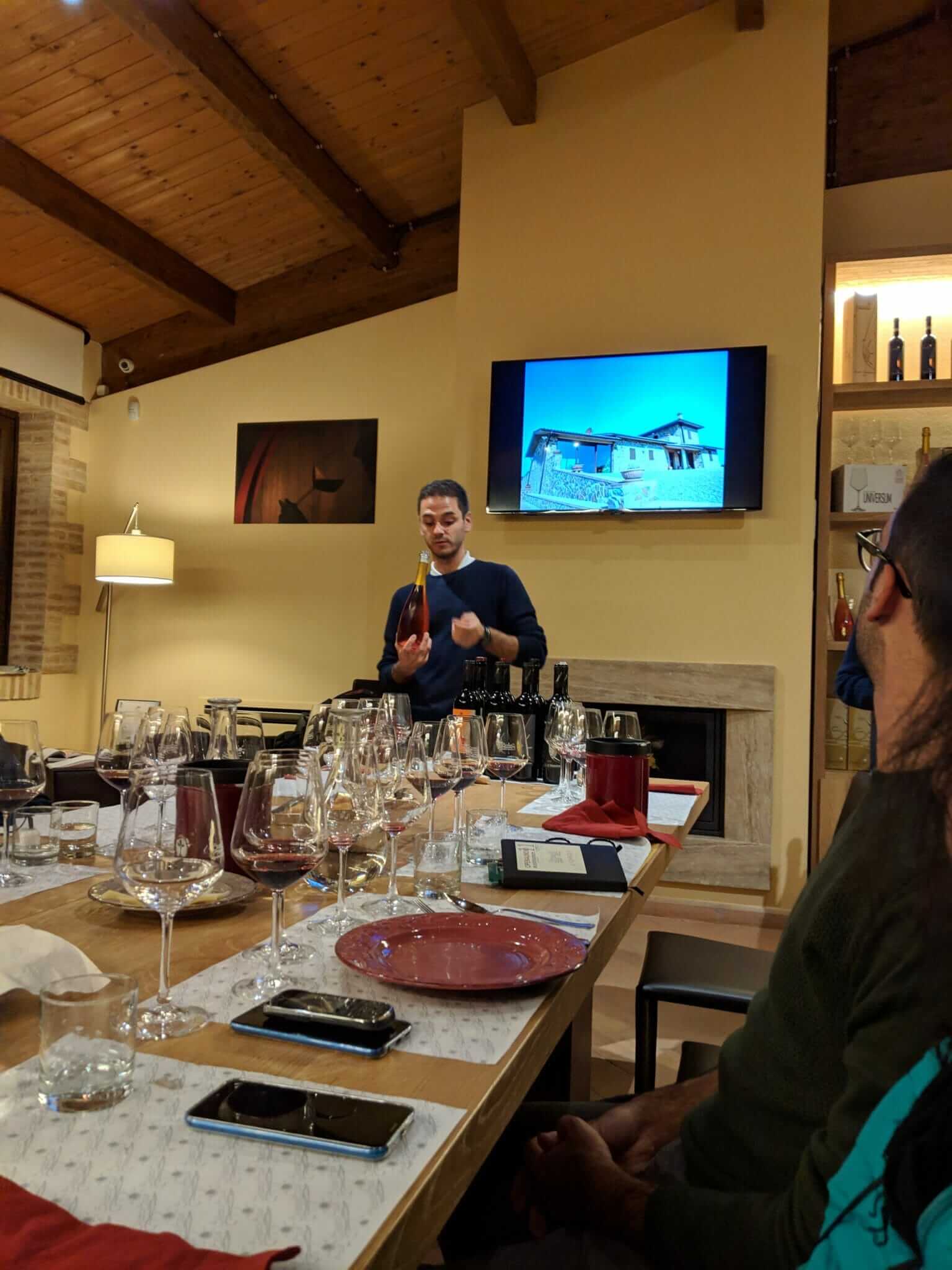
It was quite a treat to visit the winery Sasso di Sole. Lorenzo was my host and gave me tour of this very modern winery which produces Brunello di Montalcino wine as well as Orcia DOC wines.
The family has farmed this land since the 17th century.
Though the owner was not present that night, his young son Tomas made a fabulous impression.
Just ten or eleven years of age, he spoke English perfectly and was already very savvy about grapes and wine.
After the winery tour, Lorenzo invited me to the modern tasting room for a very formal tasting of their wines, followed by a delicious dinner.
2014 Orcia DOC Rosso
100% Sangiovese: from younger wines. Fresh and vibrant.
2013 Brunello di Montalcino
100% Sangiovese: very vibrant wine with tart acidity and silky tannins.
2014 Brunello di Montalcino
100% Sangiovese: jammy ripe fruit balanced by vibrant acidity. Long length of finish
2012 Brunello di Montalcino Riserva
100% Sangiovese: very ripe concentrated fruit with velvet tannins at this early state. An herbal quality in addition to flavors of red cherry.
A delightful visit from a generous host.
ORCIA DOC: Cantina Campotondo
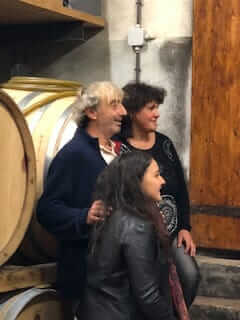
The Orcia DOC as often described as having a rugged, almost wild natural beauty.
This can certainly be said of the day I was greeted by our host Elena Salviucci. She welcomed me to her home and winery Cantina Campotondo on an exceptionally stormy day.
The Salviucci family was a pioneer in this region of Campiglia d’Orcia. The vineyards are located right between the mountain side and the valley slope.
Elena, just 23, explains that her father Paolo created the winery in the year 2000.
Today they produce 11,000 bottles a year. What’s most special about the winery is that the soil is mostly loam, sand, and clay but it is very rocky.
It is beneficial that there is a great difference of diurnal temperature (drastic fluctuations between day and night).
2017 Tavoleto Chardonnay
Elena begins the tasting with a Chardonnay, quite refreshing and delicious. Paolo loves Chardonnay and this was the first grape he planted.
There is no oak or malolactic fermentation in this wine, even though it tastes rich and creamy. It is an entry level wine but it has complexity and long length of finish.
2016 Mezzodi Di Campotondo Orcia
This wine is100% Sangiovese matured in steel tanks. It is a garnet translucent color with pleasant bitter red and black cherry flavors and a long length of finish.
2015 Banditone Di Campotondo Orcia
This wine is a blend of 90% Sangiovese, and a 10% blend of Merlot and Colorino. 12 months aging in Slavonian oak and 2nd and 3rd use French barrique.
It is a rich full-bodied wine with a fresh red cherry flavor and a pleasant bitter twist. This 2015 marks the 10th year of this brand.
2015 Il Tocco Reserva
This wine is 90% Sangiovese and 10% Colorino with minimum of 24 months aging. It is a very concentrated full bodied wine with great depth of flavor and a long length of finish.
Poggio Grande
Orcia DOC: Poggio Grande

Pretty dark haired Giulitta Zamperini greets me at her family’s picturesque Orcia DOC winery Poggio Grande.
Giulitta’s father Luca started this winery in 1999, though his grandparents have been making wine here for many years for personal consumption.
Of course, every wine has a story. Luca started the winery because when he was young he worked in the city. Yet after 20 years he decided to return to his village here in Orcia DOC to be with his family.
At first he made wine as a hobby and planted a small vineyard. But by 1999 he was producing one thousand bottles a year. Every year after that his production grew and he began to plant a new vineyard every single year.
Today, the family has six hectares and they produce 30,000 a year. Next year they will sell the quality level “Sangiovese Selection” with a new label.
It’s interesting to note that though Luca made the wine in the beginning, he first hired an oenologist in 2005, then hired a new oenologist along with an agronomist in 2012 to keep up with quality and production.
The tasting took place in a very pretty tasting room overlooking the lovely scenery of the Orcia DOC.
2017 Tagete
This white wine is a blend of Marsanne/Rousanne. It is full bodied white wine with ripe peach flavors and vibrant acidity.
The reason for this unusual white blend is because some of the soil is calcareous. Luca searched eight years for the right international grapes, eventually finding it in a blend of the French Rhone varieties Marsanne and Roussanne.
To make this wine, Luca harvests by hand in the morning to keep the wine fresh. Then he puts the grapes in tank for a week at 4 degrees Celsius, followed by fermentation in wood.
Maturation is six months with batonnage, then the wine is put in wood for the fermentation. The wine ages for six months then it rests in bottle. Only 2500 bottles are produced.
The wines are mostly sold to private clients and sommeliers that can explain the unusual (for Italy) grape blend and the style.
2016 Piano
This is the entry level red wine made only from Sangiovese grapes, to drink for everyday occasions. Very fresh acidity and light style. It ages only three months in a barrel.
2015 Scorbutico
This red wine is named after one of the family’s horses. Horse racing is another passion of the family. The name Scorbutico means “grumpy” in English.
The wine is a blend of 70% Sangiovese, 15% Syrah, 10% Cabernet Sauvignon 5% Merlot. 2015 is the first year that the family uses four different grapes. Every year they try to make different blends and select the best blend with their enologist.
This wine ages for one year in new barrique. The family decides with their enologist what barrel they want, and they then find a barrel maker to create the one they desire. This wine is very complex with many layers of flavor, cherries both red and black.
2015 Sesterzo
This is the most important wine made here. It is from a single vineyard so it is cru quality, and It takes its name from a Roman coin found in the vineyard. 2015 was a very good vintage for Sangiovese.
This wine is aged in tonneaux for 30 months, with a very long maceration.(40 days) on the skins. It is an extremely rich, full bodied wine with a long length of finish.
2015 Syrah (actual name of the wine, and 100% Syrah)
Only 2000 bottles are produced of this IGT wine. It is a translucent color with very pure red cherry taste.
This is Luca’s favorite wine because Syrah is first grape variety he planted.
Barrel fermentation and then aged in barrique for 18 months. The vineyard is at a high elevation it has great intensity of flavor and sharply defined aromatics.
The Lunch
A very familial lunch with lots of pasta, vino, and fun!
Luca introduced his new pasta brand (Poggio Grande Pasta di Grano Senatore Cappelli)
We enjoyed various vintages of the wines at the tasting, paired with some amazing food. We also enjoyed the excellent olive oil the family produces.
It was a wonderful lunch filled with great wines, fabulous pasta and olive oil, and the warmth of this lovely Italian family.
2011 All Inontro
This unusual IGT wine is 100% Colorino. Only 350 bottles are made. It is delicious! One week before harvest they press the stems of the hanging grapes in order to let them dry on the vine.
Then they wait and make sure it is the last to be harvested. They “cold soak” the grapes to extract the tannin and flavor.
For maturation they only French barrique for a minimum of 24 months. The wine is very full bodied with assertive though velvet tannins and a dry finish.
2006 Banditone Orcia
This delicious wine is made from 90% Sangiovese and 10% a blend of both Merlot and Colorino. Very rich and full bodied with red and black cherries and a touch of oak. A wine that can age even further.
After the tasting, Elena and her parents served a delicious lunch to enjoy with the wine. Elena speaks English beautifully and many thanks to the family for hosting our visit, tasting, and lunch.
Orcia DOC: Historical Attractions
The Orcia DOC region of Tuscany has a wild beauty quite unlike any other region. While the gorgeous natural scenery of sky, hills, and rivers might have visitors snapping their heads to take it all in, you will find many historical attractions to visit as well.
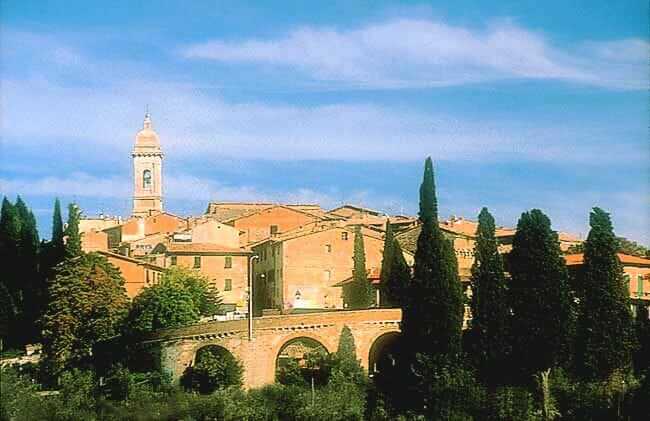
One such attraction is the ancient “Castle of Vignoni” – San Quirico d’Orcia.
This castle was a residence of the Salimbeni in the 12th century and includes a tower and Romanesque church. The village surrounding the castle looks deserted, and there is a pleasant yet eerie silence about the area, especially on a chilly grey day.
Bagno Vignoni
Another “must see” is the village of Bagno Vignoni, famed for centuries for its thermal waters. This village is located in the Val d”Orcia National Park.
It was a highlight of my trip to see this ancient Roman creation, and a lot of fun to imagine the Romans all enjoying the warm thermal waters before plunging into the natural cold pool.
This “spa” of sorts was also visited by Pope Plus II, Saint Catherine of Sienna, Lorenzo the Magnificent and others.
La Posta Hotel
Just a few minutes away, at the very elegant and posh La Posta hotel.
I was able to enjoy the same thermal waters in their baths. Guests are given a robe, a towel, and a cap and then can enjoy the waters (for a fee).
This hotel is absolutely gorgeous, with floor to ceiling views of the hills in the formal dining room and certainly worth a visit (or a stay).
Like this article? Chcck out these excellent wine book reviews here.
Please SHARE this article visit the social media links and subscribe to my newsletter here
If you like this article you will like:
— Dominus Estate
— Chappellet Family Winery
— Hess Collection
— Frog’s Leap
Curious to Learn More About Wine? Start Here
About Author Marisa D’Vari
D’Vari contributes to Forbes.com, Financial Times, World of Fine Wine, Quarterly Review of Wine, Decanter Robb Report, San Francisco Chronicle, South China Morning Post, and more.
She holds the (WSET) diploma, Certified Sommelier through the Court of Master Sommeliers, a Certified Wine Educator through the Society of Wine Educators … to see it all, please click on bio
**New to A Wine Story? Start Here**